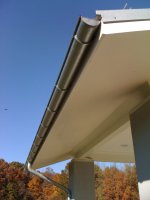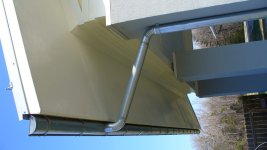I have a metal roof, and thought long and hard about grounding it. The company that put in the roof had all horror stories about having someone install lighting rods on it. I also have all metal 6" gutters and metal 4" downspouts on the roof. So I decided to connect each gutter to the roof with a 2" 1/2" wide stainless steel strap, and then took the bottom of each gutter and tied it into a ground. I have 3 roofs with the following connection scheme: 1 connection (smallest, hidden section), 2 (fairly large roof over garage) and 6 (main roof).
The ground system is 1200 feet of copper. 600' in the ground around the house and some other areas, about 400' of #2 and 200' of #6. Easy to do with new construction. Then I have four 150' runs in various trenches that come out from the house for other services. The ground system connects to the AC ground at one point inside the house right at the service entrance.
Here are pix of the ground connection and the gutters. A stainless steel hose clamp goes to a stainless steel strap, then the copper connection point and copper ground wire. You should not connect copper to galvanized metal directly. You will get galvanic corrosion. You need to inspect these points annually. I spray some lub on them in the hopes that it will go where water might go and thus cut down on any chance of corrosion. This year I might spray with Fluid Film.
Disclaimers: This system design is a SWAG on my part, but I've been involved in lighting protection work in the past. I suspect this is better than nothing, but there is the chance of damage to the roof if it takes a strike. I'm balancing the chance of that damage vs. the damage of a bad installation of a traditional lighting rod system. The traditional lightning rod system can handled a larger current strike better.
Lightning data/folklore: Way back in time, the Bell System did a lot of studies on lightning. There are some pieces of that which stuck with me. A bolt of lightning can have as little as 5,000 amps and as much as 500,000 amps of current. The "typical" or average current is about 20,000 amps. So you can do a SWAG system, take a hit, do just fine, and think you've got it. Then you get a 100,000 amp strike and the results are very different. So to me a lighting protection system moves the decimal point on the odd that you'll get a strike and be destroyed over a place or two. The 2nd half of all lightning protection systems is good full replacement insurance.
A 1.5" copper strap is used a lot for commercial protection. A 6" strap (or two or three of them) is what you see on a cell tower at the bulkhead where the cables enter the building. So my little 1/2" stainless steel is the weak link, but there are a few of them per roof and their length is only 2" long. If I got a big strike, it would vaporize and I'd have some repair work.
I've seen about 3 houses that got hit with lightening and had shingle roofs. The lightning traveled on the shingles until it hit the aluminum facia (plastic covered). It then traveled around the house and found the coax coming from the satellite dish. That coax was vaporized down to the protection block. The ground off that block was often a #10 to a bad ground rod or the telephone/AC ground. Other than the entry and exit points, the facia was OK. Now if any of those houses had a high current hit, they would be on fire. So I'm _hoping_ that the roof, gutters, and downspouts have plenty of area, the #6 ground wire (which is also what is used as the ground wire on a telephone or power pole) is big enough, and the ground ring is OK.
The topic of whether or not you can dissipate enough charge through some system to avoid a strike has been debated forever. I suspect that in some cases it makes a difference, in others it doesn't. What is clear (and SPIKER refers to this) is that after a strike you must inspect the system for damage. It is not uncommon for a single ground rod to be bad after a strike. The more surface area in your grounding system, the better it can take multiple hit. One tower I have some equipment on has over 100 ground rods and can take multiple hits with no worry about the quality of the ground. There is a device your power company may have that can measure the impedance (resistance) of your ground system, they may be able to help you after a strike.
Key idea here is that a single ground rod, IMHO, is really not enough. Since the OP is building a home, there should be plenty of opportunity to put some wire in the ground around the home and get a good ground system.
Other comments: When I was doing the ground system, I went to a marine store and bought a large and small zinc anode. I connected them both. The large is down deep in the ground, the small is where I can dig it up every 5 years to see how the anodes are doing. The buried propane tank has it's own anode it came with, and that is tied into the system too. The goal is simple- if there are any problems with galvanic corrosion I want to eat up the anodes.
Be sure to put a whole house surge protector in the breaker box, and that AC ground should tie into the lighting ground at one point with a #6 wire.
If you are handy with things, and are around during construction this approach is cheap and easy. If you are at all uneasy about this approach, pay someone to put in a system but go talk to a few people they have done jobs for to see if they know how to work with/on a metal roof.
Hope this helps, another too long Pete post

Wish I could preview the pix, don't know why the rotation happens.
Pete


